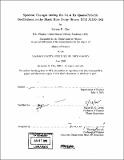Spectral changes during the 0.1-4 Hz quasi-periodic oscillations in the black hole X-ray binary XTE J1550-564
Author(s)
Cho, Steven N. (Steven Nicholas)
DownloadFull printable version (3.804Mb)
Other Contributors
Massachusetts Institute of Technology. Dept. of Physics.
Advisor
Walter H.G. Lewin.
Terms of use
Metadata
Show full item recordAbstract
In this thesis, we describe the analysis of 0.1-4 Hz quasi-periodic oscillations (QPOs) of the black hole X-ray binary XTE J1550-564 using data obtained with the Rossi X-ray Timing Explorer (RXTE) satellite. Data from 13 consecutive observations spanning eight days were included in this analysis. By comparing the spectra of the source when it is in the high intensity phase with the low intensity phase of its QPO cycle, we hoped to gain insight into the cause of QPOs and how they relate to structures and processes in the vicinity of black holes. Like observations from the black hole X-ray binary GRS 1915+105 (Miller and Homan 2005), our observations from XTE J1550-564 showed a significant difference in the Fe ... line equivalent width between the high and low intensities of the QPO for 6 of 13 observations. However, 2 of 13 observations exhibited the opposite effect in that the Fe K [alpha] line equivalent width actually dropped significantly during periods of high intensity. Moreover, we found that the integrated flux of the Fe K [alpha] line was proportional to the flux of the continuum in 5 of 13 observations. Despite these competing effects, the ratios of the low intensity and high intensity spectra indicate an increase in the QPO strength up to about 10 keV, above which it decreases only slightly. We also found dramatic changes in the QPO strength at low energies as the QPO frequency increases. We believe this to be the result of an increase in relative contributions to the spectra as the disk blackbody component becomes more important. (Cont.) In this thesis, we discuss five possible spectral models to explain QPOs based on the behavior of Fe K [alpha] emission lines. Then we describe whether or not our results agree with those predictions. Although our results show correlations similar to those found by Miller and Homan (2005), they also show anti-correlations in several observations. Our results support Miller and Homan's suggestion of a link between discrete timing features (QPOs) and spectral features (Fe K [alpha] emission lines) which occur in the inner disk around black holes. Our work shows that current explanations for QPOs have some physical basis, suggesting that QPOs are due to either a quasi-periodically changing reflector area in the accretion disk or an episodic modulation of the hard flux component in the corona or jets that irradiates the accretion disk. Our results also suggest that perhaps the correct model is something more complex that goes beyond current models and is able to explain the multiple effects observed in the Fe K [alpha] line.
Description
Thesis (S.M.)--Massachusetts Institute of Technology, Dept. of Physics, 2005. Includes bibliographical references (p. 61-62).
Date issued
2005Department
Massachusetts Institute of Technology. Department of PhysicsPublisher
Massachusetts Institute of Technology
Keywords
Physics.